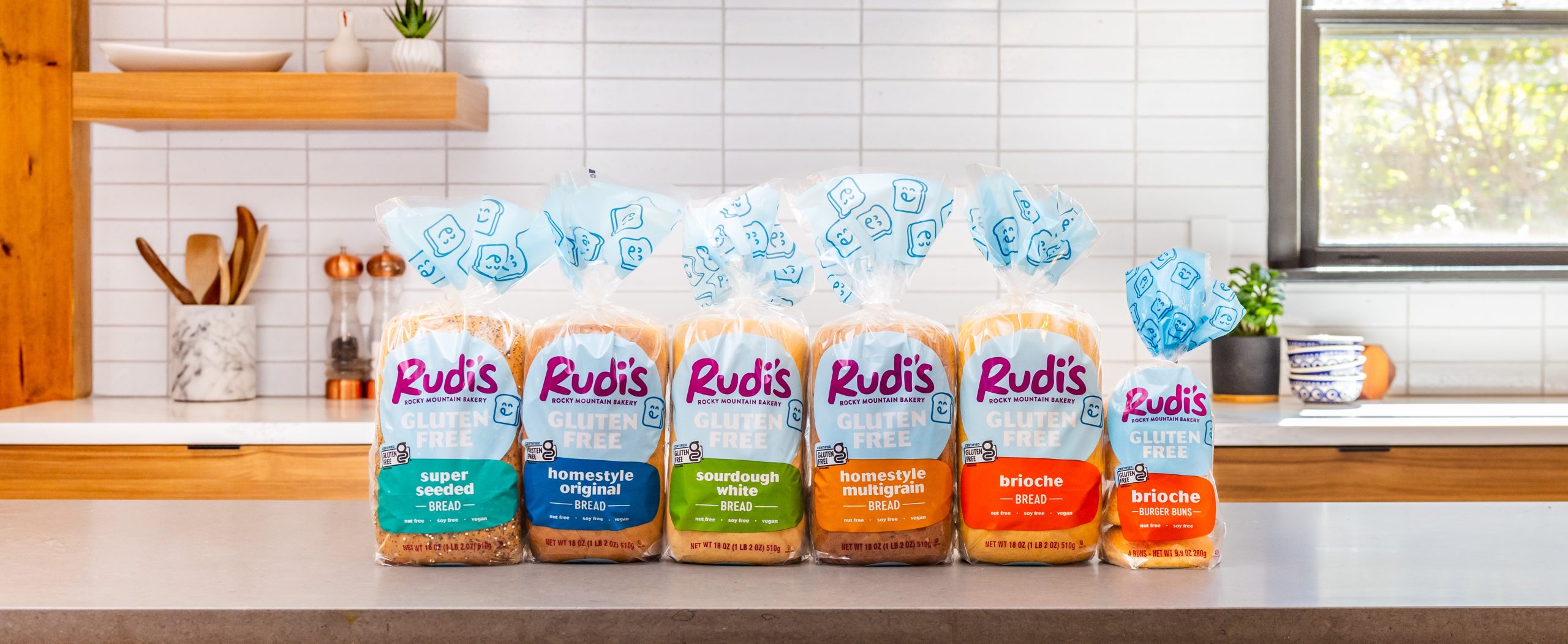Celiac disease is also referred to as coeliac disease, celiac sprue, non-tropical sprue, and gluten sensitive enteropathy. It is an autoimmune disease that occurs when the ingestion of gluten (a protein in some foods) results in damage of the small intestine.
When someone with celiac eats gluten, their body issues an immune response that damages the villi that line the small intestine. Villi are small fingerlike projections that help the small bowel absorb nutrients from food. When the immune system attacks the villi, the body can’t absorb nutrition efficiently.
What we know about celiac disease continues to evolve. The autoimmune disorder was first written about in 1888. Then in 1924, a pediatrician made a landmark discovery that babies with the condition improved when they ate a diet of only bananas. In the 1930s, another pediatrician made a link between celiac and eating wheat. In the 1990s, genetic markers of celiac were discovered. And in 2010, Rudi’s was one of the first commercial bakeries to introduce a line of certified gluten-free breads.
Celiac disease can occur at any age and it is diagnosed with a blood test. The testing looks for antibodies in the blood, and elevated levels of certain antibody proteins indicate an immune reaction to gluten. Genetic testing for human leukocyte antigens also can be used to rule out celiac disease.
A biopsy is often a follow up and can confirm a diagnosis of coeliac disease. At a gastroenterology center, a health care professional performs an endoscopy. They do so by inserting an endoscope through the mouth and into the small intestine, where they take samples of the lining of the small colon and examine it for celiac disease symptoms and signs.

Symptoms Of Celiac Disease
The symptoms of celiac disease are wide ranging and vary greatly. Someone may present with one, a few, or many of these symptoms. They include digestive symptoms, as well as health problems related to skin, nerves, and more.
- Chronic diarrhea or constipation
- Fatigue and headaches
- Malnutrition and weight loss
- Bloating and abdominal pain
- Nausea and vomiting
- Iron deficiency anemia
- Osteoporosis or softening of bones
- Itchy, blistery skin rash, called dermatitis herpetiformis
- Mouth ulcers
- Joint pain
- Infertility and miscarriage
- Iron deficiency anemia
- Lactose intolerance
- Liver disease or kidney disease
- Irritable bowel syndrome
- Neurological symptoms, including tingling in the feet and hands, ADHD, lack of muscle coordination, seizures, ataxia, dementia, peripheral neuropathy, myopathy, and multifocal leucoencephalopathy
- Pancreatic insufficiency
- Small intestine cancer and non-Hodgkin lymphoma
- Vitamin and mineral deficiencies
Risk Factors And Stats On Celiac
The most cited study on celiac disease says that 1 in 133 Americans (or 1% of the population) has it. But that estimate is based on data more than 20 years old, and newer screenings show rates are likely higher and climbing. Pediatric screenings, for example, put the estimate closer to 2% of American children. If you have a first-degree relative with celiac, the risk factor increases to a prevalence of 1 in 22.
Celiac disease is also more commonly diagnosed in people with certain autoimmune conditions, such as type 1 diabetes, thyroid disease, multiple sclerosis, and autoimmune hepatitis, than it is for people with no autoimmune condition.
There’s also a condition called non-celiac gluten sensitivity, which is a consistent adverse reaction to eating gluten-containing foods. Symptoms most often relate to distress of the gastrointestinal tract, and the main one is diarrhea. But they can also include frequent belching, fat in stools, heartburn, indigestion, nausea, vomiting, and flatulence. There is currently no valid blood, stool, or saliva test to diagnose gluten sensitivity, but survey data puts the estimate at 0.5% to 13% of the population. Women, teenagers, and people in their 30s and 40s report the most symptoms.
The best–and only–treatment for celiac disease is a strict avoidance of gluten. People with non-celiac gluten sensitivity should also avoid gluten in order for symptoms to improve.
What Foods Have Gluten?
Even though gluten is found in carb-containing foods, it is actually a protein. There are two main types of gluten proteins:
- gliadin, which gives food height
- glutenin, which gives foods elasticity and texture
Gluten proteins are found in grains, but not all grains contain gluten. These ones do:
- Wheat – wheat berries, durum, emmer, semolina, spelt, farina, farro, graham, khorasan (kamut), and einkorn
- Rye
- Barley
- Triticale – a cross between wheat and rye
Common foods that contain these grains (and therefore contain gluten) are many, but not all, types of:
- Breads, rolls, and flour tortillas
- Pasta
- Baked goods and snacks
- Cereals
- Beer and some other alcohols
And sometimes, these foods contain gluten, too:
- Soups – often include a gluten-containing grain or are thickened with wheat flour
- Sauces and rouxes – often thickened with wheat flour, especially “brown sauces”
- Salad dressings – often thickened with wheat flour
- Malt vinegar – made with barley
- Soy sauce, shoyu, and miso – often includes wheat or barley
- Oats – this grain is naturally gluten-free, but it’s often processed in facilities that also process gluten-containing grains, so there can be contamination; people with celiac disease should seek out certified gluten-free oats
- Lunch meats and deli meat – sometimes contain hydrolyzed wheat protein
- Imitation meats, burgers, and seafoods – veggie burgers and imitation crab, for example, sometimes contain wheat or other gluten-containing grains
View Rudi’s Gluten-Free Products
5 Things To Know About Celiac Disease
- The only treatment is to avoid gluten. There aren’t medications or certain times that make it OK for someone with celiac disease to eat gluten, which is why label reading and looking for certified gluten-free products is a constant practice for people with celiac disease.
- It’s an autoimmune disease. Eating gluten triggers an autoimmune response in the digestive system of someone with celiac, and overtime these flare ups damage the lining of their small intestine causing long-term issues.
- It can cause other nutrient deficiencies. A 2019 study suggests that people who have been following a gluten-free diet for six months or longer should test for nutritional deficiencies, such as low levels of folic acid, vitamin B12, vitamin D, calcium, iron, zinc, selenium, and magnesium. Sometimes supplement therapies will be recommended by a gastroenterologist or registered dietitian.
- Gluten can also be in makeup and medications. For people with celiac disease, it’s important to avoid gluten even in non-food items, such as medications or personal care products that use gluten-containing grains as a bulking or texture agent.
- Social life can be hard. The impact that a strict gluten-free diet has on someone’s social life is a major hurdle. It’s challenging to attend events and travel when maintaining a strict gluten-free diet. For children, the impact can be more significant since they don’t have the level of understanding of the health impacts that adults typically do. For adolescents, it’s a challenge because so much of their social life is based on fitting in. It’s hard for adults and the elderly, too, since their social circles may misunderstand it to be a fad diet.
Rudi’s Has Offered Gluten Free For 14 Years
Rudi’s officially launched their line of certified gluten-free breads in May 2010 so that even more people could enjoy healthy and delicious bread. For years, people had been asking Rudi’s for gluten-free breads that were just as delicious as their organic breads. So their master bakers worked with gluten-free experts for more than 15 months to develop really good gluten-free bread that was up to their high standards.
Rudi’s gluten-free bread is made in a dedicated gluten-free bakery. They go above and beyond to ensure their bread is safe for people with celiac disease. Every batch of Rudi’s gluten-free bread is tested to make sure it’s below 5 ppm of gluten before being distributed to stores. In addition, all incoming ingredients are tested and certified to be gluten-free. Rudi’s also sends their products to an outside lab to validate their internal test results, ensuring less than 5 ppm of gluten.
THE BOTTOM LINE
Estimates say 1 in 133 people have celiac disease, and the true number is likely higher, maybe even twice that much in certain regions. An even larger number of people have non-celiac gluten intolerance. The only treatment for both conditions is to avoid gluten, which appears in many common foods, especially breads, baked goods, pasta, and cereals.
Written by Jessie Shafer.
Jessie is a Registered Dietitian Nutritionist living in Colorado where she splits her time among nearby playgrounds, typing away at her trusty laptop, and heating up her home kitchen with delicious experiments. A former magazine editor-in-chief, Jessie has a long career in food publishing and health writing. She is currently the editor at The Real Food Dietitians and a nutrition consultant through her business crdible.










